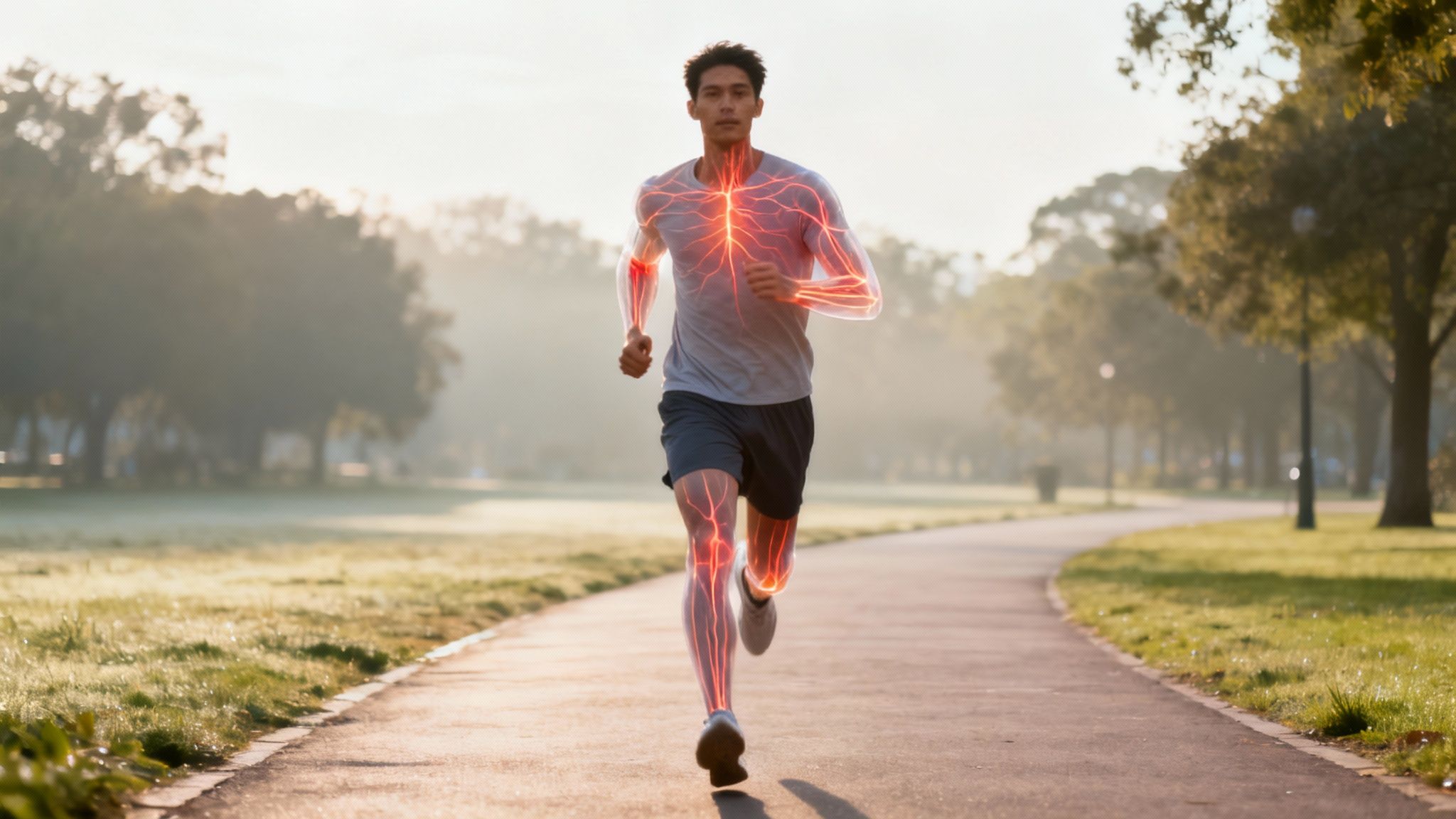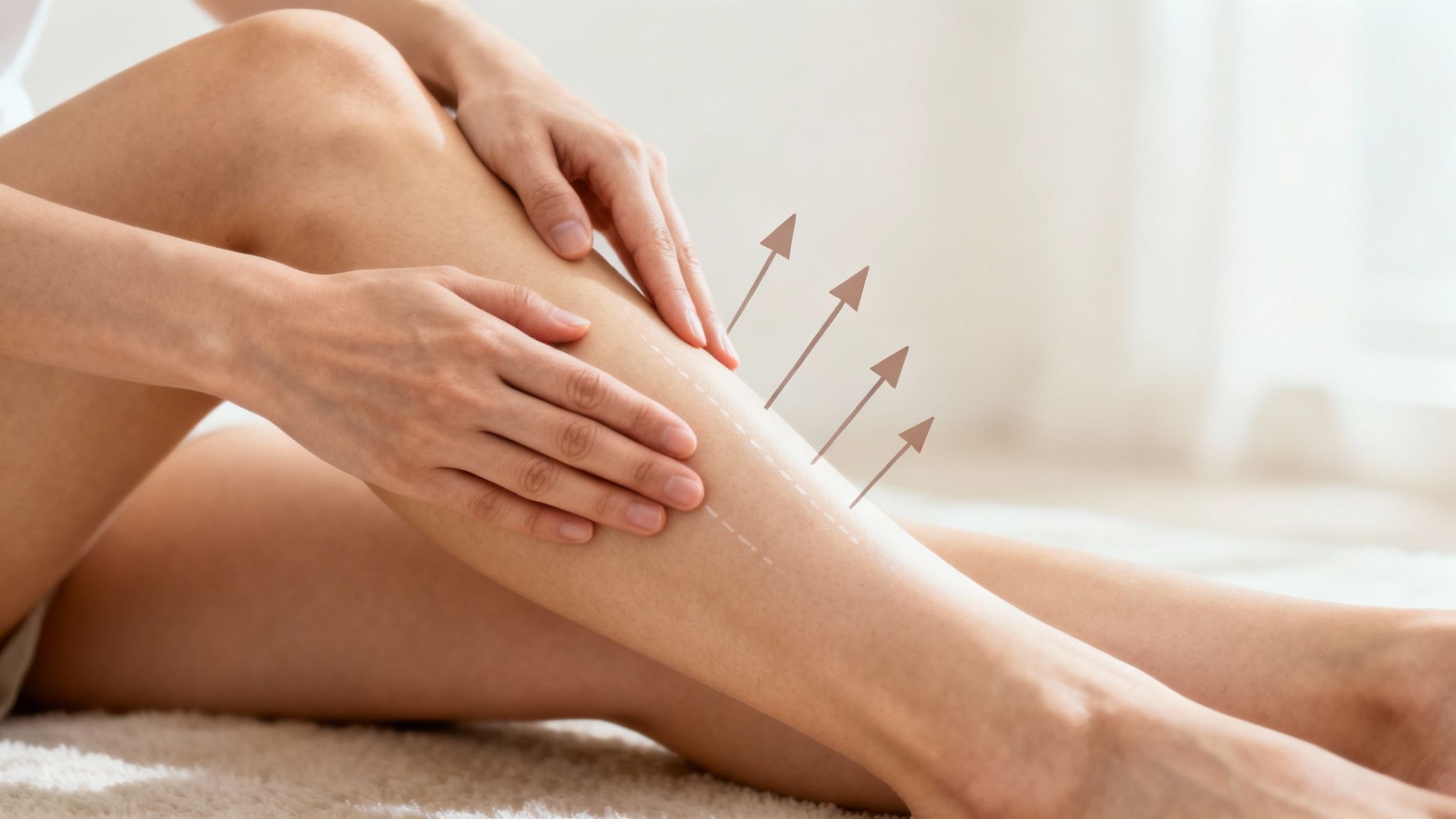
Ever feel that pins-and-needles sensation in your feet or notice your hands are perpetually cold? You’re not alone. Poor circulation is a common issue affecting everyone from dedicated athletes to office professionals. Fortunately, there are many simple and effective ways to improve blood circulation naturally, which supports everything from muscle recovery to daily energy levels.
Your circulatory system is the vital delivery network that transports oxygen and nutrients to every cell. When it functions optimally, you feel more vibrant and focused. When it's sluggish, you might experience fatigue, stiffness, or discomfort.
This guide provides ten practical strategies to support your circulation and overall well-being. We’ll explore actionable steps from diet and exercise to self-care practices using tools like the Cryotex Massage Gun. Let's get started.
1. Get Moving with Regular Aerobic Exercise
Think of aerobic exercise as a tune-up for your circulatory system. Activities like brisk walking, cycling, or swimming strengthen your heart muscle. A stronger heart pumps more oxygen-rich blood with every beat, making it one of the most effective ways to improve blood circulation naturally.

When you engage in regular aerobic activity, your body creates more tiny blood vessels. This expanded network creates more pathways for blood to travel, ensuring even your extremities get the nourishment they need.
How to Get Started
Consistency is more important than intensity. Aim to make movement a regular part of your life.
- Set a weekly goal: The American Heart Association recommends 150 minutes of moderate-intensity aerobic activity per week. This could be 30 minutes, five days a week.
- Choose activities you enjoy: You're more likely to stick with an exercise plan if it's fun. Consider dancing, hiking, jogging, or a recreational sports team.
- Start slowly: If you're new to exercise, begin with 10-15 minute sessions and gradually increase the duration as your fitness improves.
A stronger heart is a more efficient heart. You can learn about other ways to naturally lower your resting heart rate as your cardiovascular fitness improves.
2. Stimulate Your Skin with Dry Brushing
Dry brushing is a simple technique that acts as a manual stimulant for your circulatory system. This practice involves using a natural, stiff-bristled brush to gently sweep across your skin. The light pressure encourages blood flow to the surface, giving your skin a healthy glow and supporting overall circulation.
This method works by exfoliating dead skin cells and stimulating nerve endings, which boosts blood movement in the tiny capillaries just beneath the skin. It’s one of the simplest ways to improve blood circulation naturally, requiring minimal time.
How to Get Started
Make this a regular part of your pre-shower ritual for the best effects.
- Choose the right tool: Opt for a brush with firm, natural bristles and a long handle to easily reach your back.
- Use upward strokes: Always brush toward your heart. Start at your feet and move up your body using long, smooth strokes.
- Be gentle: A session should only last 5-10 minutes. Use light pressure and avoid brushing over broken skin, rashes, or sensitive areas.
3. Boost Flow with Yoga and Stretching
Yoga and stretching are dynamic practices that directly support your circulatory health. Moving your body through various poses compresses and releases different areas, helping push out stagnant blood and allowing fresh, oxygenated blood to flow in. This is a gentle yet powerful way to improve blood circulation naturally.
The combination of physical postures (asanas) and controlled breathing (pranayama) helps lower blood pressure and reduce stress, both of which can negatively impact circulation. Poses like inversions (e.g., Legs-Up-the-Wall) use gravity to promote drainage from your lower extremities.
How to Get Started
Focus on mindful movement rather than perfect poses.
- Practice consistently: Aim for 3-4 sessions per week. Even 15-20 minutes can make a difference.
- Hold your poses: Try to hold each stretch for at least 30-60 seconds to allow your muscles and blood vessels to respond.
- Focus on your breath: Pair your movements with deep, steady breathing. Inhale as you lengthen and exhale as you deepen a stretch.
Stretching is also a key component of recovery after exercise. Learn more about how to reduce muscle soreness to complement your routine.
4. Try Cold and Hot Water Therapy (Contrast Therapy)
Think of contrast therapy as a workout for your blood vessels. This technique involves alternating between hot and cold water, causing your blood vessels to rapidly widen (dilate) and narrow (constrict). This "vascular gymnastics" trains your vessels to be more responsive and is a dynamic way to improve blood circulation naturally.

This method is widely used in sports medicine for recovery. When blood vessels constrict in the cold, it helps reduce inflammation. When they dilate in the heat, fresh, oxygen-rich blood floods the area. This flushing action supports circulation and helps decrease muscle soreness.
How to Get Started
You can easily incorporate contrast therapy into your shower.
- Start gradually: Begin with a warm shower, then switch to cool water for about 30 seconds.
- Follow a cycle: A common protocol is 1-3 minutes of hot water followed by 30-60 seconds of cold water. Repeat this cycle 3 to 4 times.
- Always end on cold: Finishing with a cold rinse helps constrict blood vessels, which can reduce inflammation and leave you feeling energized.
5. Spice Things Up with Cayenne Pepper
Adding heat to your meals can be one of the tastiest ways to improve blood circulation naturally. Cayenne pepper contains a compound called capsaicin, which helps stimulate the release of nitric oxide. This relaxes the inner muscles of your blood vessels, allowing blood to flow more freely.
The warming sensation you feel after eating spicy food is a direct result of this enhanced circulatory activity. Capsaicin encourages vasodilation, or the widening of your arteries and capillaries. This process not only supports better blood flow but also provides antioxidant and anti-inflammatory benefits.
How to Get Started
Incorporate cayenne pepper into your diet slowly and consistently.
- Start small: Begin by adding just a pinch or 1/4 teaspoon of cayenne powder to soups, stews, or chilis.
- Increase gradually: As your tolerance for heat grows, you can slowly increase the amount. Always consume it with food to avoid stomach irritation.
- Aim for consistency: Try to include foods with capsaicin in your meals at least 2-3 times per week.
6. Practice Deep Breathing Exercises
The simple act of breathing deeply holds profound power over your circulatory system. Deep, controlled breathing (diaphragmatic breathing) increases your oxygen intake and stimulates the parasympathetic nervous system. This "rest and digest" response helps relax your blood vessel walls, allowing blood to flow more freely.
When you practice conscious breathing, you enrich your blood with higher levels of oxygen, which is then delivered to every cell. This technique is used by everyone from yoga practitioners to military operators to manage stress and maintain peak performance.
How to Get Started
Create a small, quiet moment for yourself each day.
- Practice daily: Dedicate 5 to 10 minutes each day, perhaps in the morning or at night to unwind.
- Use the box breathing technique: Inhale slowly for a count of four, hold for four, exhale for four, and hold again for four.
- Focus on your diaphragm: Place a hand on your belly. As you inhale, you should feel your stomach expand outward. This ensures you are taking a deep breath.
For another method of stress relief that also aids circulation, explore the benefits of percussion massage therapy for muscle recovery.
7. Use Massage and Self-Massage
Massage is a targeted way to manually encourage blood flow exactly where you need it most. Applying pressure to muscles and soft tissues helps push stagnant blood out of congested areas and pulls fresh, oxygen-rich blood in. This not only reduces muscle tension but also stimulates the lymphatic system, which helps clear waste.

This direct stimulation is one of the most immediate ways to improve blood circulation naturally, providing relief to sore or tight areas. Modern tools like percussion massagers make these benefits easily accessible at home. For instance, the Cryotex Massage Gun comes with multiple attachments, allowing you to customize pressure and target specific muscle groups to promote local blood flow.
How to Get Started
Integrating massage into your routine is simple and highly effective.
- Target problem areas: Spend 5-10 minutes daily massaging areas that feel tight, like the calves, neck, or shoulders.
- Use proper technique: Apply firm but comfortable pressure, moving in long strokes toward your heart.
- Incorporate helpful tools: A percussion massage gun can effectively target tense muscle knots.
- Stay consistent: Aim for short self-massage sessions daily and consider a professional massage monthly for more comprehensive treatment.
A hands-on approach actively supports your body's circulatory health. You can explore the many benefits of using a massage gun to see how this technology can enhance your practice.
8. Elevate Your Legs
Harnessing gravity is a low-effort way to improve blood circulation naturally. Elevating your legs helps the flow of deoxygenated blood back to the heart (venous return). This simple posture reduces pressure on your leg veins and lessens the strain on your cardiovascular system.
This technique is often recommended for managing swelling (edema) and is a favorite among athletes for accelerating recovery. It's also great for travelers on long flights to support blood flow and reduce stiffness.
How to Get Started
This gentle practice can provide noticeable benefits for comfort and circulation.
- Practice daily: Aim to elevate your legs for 10-15 minutes at a time, once in the morning and once in the evening.
- Use proper positioning: Lie on your back and prop your legs up with pillows until they are above your heart. You can also rest your legs up against a wall.
- Stay safe: If trying gentle inversions like a supported shoulder stand, start by holding the position for only 1-3 minutes.
For those seeking advanced recovery, you can learn more about how compression boots enhance circulation and complement these natural techniques.
9. Harness the Power of Garlic and Onion
Including garlic and onions in your diet is a flavorful strategy to improve blood circulation naturally. These vegetables contain sulfur compounds, like allicin, which support cardiovascular health by promoting vasodilation (the widening of blood vessels). This allows blood to flow more freely.
The benefits of these common kitchen staples are well-documented. The bioactive compounds in these foods help reduce blood stickiness and may contribute to lower cholesterol levels, further supporting a healthy circulatory system.
How to Get Started
Regular consumption and proper preparation are key to maximizing their health benefits.
- Activate the Allicin: For garlic, crush or chop the cloves and let them sit for about 10 minutes before cooking to create the beneficial compound allicin.
- Aim for Regular Intake: Try to include 2-3 cloves of garlic or half an onion in your meals daily.
- Broaden Your Alliums: Don't forget about other family members like shallots, leeks, and chives, which offer similar circulatory support.
To further support your system through nutrition, understanding a heart-healthy diet plan can provide a comprehensive framework.
10. Incorporate Warming Ginger Root
Ginger is a traditional remedy revered for its ability to warm the body and stimulate blood flow. The active compound, gingerol, is responsible for its pungent flavor and circulation-supporting properties. By gently encouraging blood vessels to relax, ginger helps improve the delivery of oxygen throughout your body.
This warming effect has been used for centuries in both Ayurvedic and Traditional Chinese Medicine. Research supports these ancient practices, showing that ginger consumption can positively influence blood flow and reduce markers of inflammation that might impede circulation.
How to Get Started
Integrating this powerful root into your routine is simple and delicious.
- Brew a daily tea: Steep a few thin slices of fresh ginger root in hot water for 5-10 minutes. Add a touch of honey or lemon.
- Spice up your meals: Add freshly grated or powdered ginger to smoothies, soups, and stir-fries. Aim for about one to two teaspoons daily.
- Use both forms: Both fresh and dried ginger are effective. Try to consume it three to five times per week.
10 Natural Ways to Improve Blood Circulation Compared
| Item | Implementation complexity 🔄 | Resources & efficiency ⚡ | Expected outcomes 📊 | Effectiveness ⭐ | Ideal use cases & tips 💡 |
|---|---|---|---|---|---|
| Regular Aerobic Exercise | Moderate — requires consistent routine and progression | Low cost; time-intensive (30 min ×5/wk); minimal equipment | Systemic circulation improvement, increased capillary density over weeks | ⭐⭐⭐⭐ | General cardiovascular health, endurance training; start gradually and combine strength work |
| Dry Brushing | Very low — simple technique to learn | Very low cost; 5–10 minutes; natural-bristle brush | Superficial skin exfoliation and lymphatic stimulation; limited clinical circulation evidence | ⭐⭐ | Skin care and mild lymphatic support; avoid broken or sensitive skin; 3–4×/wk |
| Yoga and Stretching | Moderate — technique and posture awareness needed | Minimal (mat); 20–30 min sessions; possible instructor | Improved vessel elasticity, reduced muscle compression, better blood redistribution | ⭐⭐⭐ | Low‑impact circulation boost and stress reduction; practice 3–4×/wk, combine with pranayama |
| Cold & Hot Water Therapy (Contrast) | Low–moderate — simple protocol but requires caution | No cost beyond water; time for cycles (1–2 min intervals) | Vasoconstriction/vasodilation training; improved vessel responsiveness and reduced inflammation | ⭐⭐⭐ | Recovery and inflammation control; avoid if cardiovascular disease or pregnancy; start mild |
| Cayenne & Spicy Foods | Very low — dietary addition | Very low cost; easy to add to meals | Temporary vasodilation, metabolic increase; antioxidant benefits with regular intake | ⭐⭐ | Dietary adjunct to improve circulation; avoid if reflux/ulcer; use small amounts 2–3×/wk |
| Deep Breathing (Pranayama) | Low — requires practice for best effect | Free; immediate and portable; 5–10 min daily recommended | Increased oxygenation, parasympathetic activation, improved HRV and calming effects | ⭐⭐⭐ | Anytime stress‑related circulation support; practice daily; avoid hyperventilation |
| Massage & Self‑Massage | Low–moderate — technique improves outcomes | Low for self‑massage; professional sessions can be costly | Local blood and lymph flow increase; reduced muscle tension; improved recovery | ⭐⭐⭐ | Targeted relief and recovery; self‑massages daily, professional monthly as needed |
| Elevated Leg Positioning & Inversion | Very low — simple positioning or short inversions | Minimal (pillows, wall, or inversion device) | Immediate improved venous return and reduced leg swelling; mostly temporary | ⭐⭐⭐ | Effective for edema, travel, varicose vein relief; elevate 10–15 min; avoid prolonged inversions if cardiac issues |
| Garlic & Onion Consumption | Very low — dietary habit | Low cost; easy culinary use | Vasodilation, reduced platelet aggregation, modest BP and endothelial benefits over time | ⭐⭐⭐ | Cardiovascular dietary support; consume regularly; consult if on anticoagulants |
| Ginger Root Consumption | Very low — dietary/supplement use | Low cost; fresh or dried forms; teas | Warming, anti‑inflammatory effects; gradual improvement in peripheral circulation | ⭐⭐⭐ | Digestive and circulatory adjunct; 1–2 tsp fresh daily; avoid high doses with blood thinners |
Start Your Journey to Better Circulation Today
Improving your circulatory health doesn’t require a drastic overhaul of your life. The most effective strategies are often simple, sustainable habits woven into your daily routine. By embracing these natural approaches, you empower your body’s intricate network to function at its best.
The journey to improving blood circulation naturally is built on small, consistent actions. It’s choosing the stairs, adding a pinch of cayenne to your dinner, or dedicating five minutes to deep breathing. Each choice contributes to a stronger, more resilient circulatory system.
Key Takeaways for a Healthier Flow
Let's recap the most impactful insights from this guide:
- Movement is Medicine: Regular aerobic exercise, targeted stretching, and practices like yoga are essential for pumping blood efficiently.
- Dietary Power: Incorporating circulation-supporting foods like ginger, garlic, and cayenne pepper can have a profound impact by helping relax blood vessels.
- Targeted Therapies Work: Techniques like self-massage offer a direct way to stimulate local blood flow and ease muscle tension. Tools like a percussion massager can be incredibly effective here.
Enhanced circulation means more energy, faster recovery, and sharper cognitive function. You are not just managing a symptom; you are actively investing in your body’s overall well-being.
Ready to give your muscles targeted support to promote blood flow? Percussion therapy from BestMassageGun.com offers a powerful, direct way to stimulate circulation and release tension. Explore our selection of recovery tools and take the next step in your wellness journey.